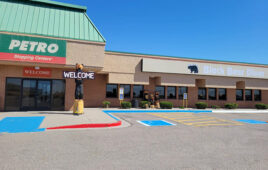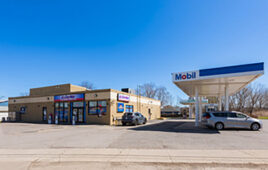 Whether it’s check cashing or the latest mobile wallet technology, providing customers with useful financial offerings can help your bottom line.
Whether it’s check cashing or the latest mobile wallet technology, providing customers with useful financial offerings can help your bottom line.
By David Bennett, Senior Editor
Cash makes up nearly 29% of U.S. consumer transactions per year, or about $1.2 trillion, according to the Federal Reserve. Among those transactions last year were a lot of excursions to use convenience store ATMs.
ATMs and other financial services aren’t new offerings in the c-store industry. However, finding the right mix of financial services that increase profit margins does require sound planning and execution.
For example, many 7-Eleven locations have kiosks that let customers cash checks for a flat 0.99% convenience fee, at any hour of the day. The major U.S. retailer also provides ATM services, money orders and transfers, and bill payment via
automatic terminals.
No-Fee ATMs Pay Off
It was about the same time that 7-Eleven was honing its plan that La Crosse, Wis.-based Kwik Trip Inc. determined that surcharge-free ATMs would draw interest from potential customers.
“We started our no-fee ATM program at the end of 2005,” said Jeff Wrobel, Kwik Trip controller. “Prior to that, we were surcharging $1.50 per transaction.”
The company reasoned that the average $1.5 million generated by transaction fees annually could easily be supplanted if patrons had access to no-fee ATMs. The family-owned business today operates ATMs in almost all of its 450 Kwik Trip, Kwik Star, Hearty Platter and Tobacco Outlet Plus locations throughout Wisconsin, Minnesota and Iowa.
Also, the concept of no-fee ATMs aligned with Kwik Trip’s inclination for offering its customers more for their money.
“We really went to this because it went along well with our market strategy for other things we’re doing in our stores. We’re very competitive price-wise on other things that we sell. We’re very different from other convenience stores in that we sell a lot of bananas, potatoes and onions—at 39 cents a pound, which is a lower price than grocery stores; is a lower price than Walmart.”
Known locally for inexpensive produce and $1 cheeseburgers, Kwik Trip has turned its growing reputation as a no-fee ATM destination into beefier, overall sales spurred by increased store traffic and robust customer loyalty.
“Over time our volume built to a high enough level that at this point now, with no-fee ATMs, we’re exceeding that $1.5 million of revenue,” said Wrobel, who explained that the volume of transactions has probably increased about five times since Kwik Trip adopted the no-surcharge platform more than eight years ago.
“Since (transactions) are very seasonal, we track them on a month-by-month basis, comparing averages per store to equivalent months in prior years, and we’ve never had a month yet where our average volumes for number of transactions—or the average volumes for cash withdrawn—have gone down. It has continued to increase every year and it still continues to increase, on an average, per store basis.”
As a result, there are more Kwik Trip customers with cash in their hands to purchase food, beverages, produce and impulse items. Wrobel estimated that five years ago, a typical ATM withdrawal averaged about $60 per visiting customer. Today, that amount has ballooned to more than $90.
If cash-spending customers are helping grow sales, it’s also alleviating the debit transactions fees that Kwik Trip pays every time other customers swipe their cards, Wrobel said.
It’s a noteworthy cost saver, especially since retailers are now stuck with a federal appeals court decision—handed down last March—allowing banks to charge retail stores a 21-cent cap on swipe fees per debit card transaction.
Checking Out
Just as ATMS are everywhere now, c-stores have expanded their financial service products to include bill paying and check cashing.
Johnson City, Tenn.-based Roadrunner Markets Inc., which operates 92 stores in North Carolina, South Carolina, Tennessee and Virginia, began offering check cashing a few years ago, a popular offering that provided a convenient service for patrons with limited options for cashing checks.
However, the process of cashing checks at the counter—customers typically need to provide one or two forms of identification, personal information, etc.—ultimately proved counterproductive because of the time involved.
“It takes away from our mission of ‘delighting customers in a way that makes them come back tomorrow,’” said John Kelly, Roadrunner’s vice president and chief operating officer. “If we have two folks working and one is spending five minutes on a check transaction, that person can’t help service other customers.”
Going Mobile
The ability to serve customers efficiently is always the goal for c-stores, and implementing new technologies is just part of the package.
With sales of mobile devices outpacing their distribution of debit and credit cards, ATM providers like Cash Depot and Diebold are looking at new ways consumers can access their cash, including a new technology called mobile cash access (MCA).
MCA, also known as cardless cash access, allows consumers to pre-stage cash withdrawals on smartphone devices creating a cooperative interaction with the ATM. Consumers authenticate themselves by scanning a tokenized QR code that signals the ATM to dispense cash via an encrypted connection.
More than 40 million Americans—20% of all smartphone users—made an e-commerce transaction in 2013 using mobile wallet technology, according to market research and consulting firm Parks Associates. Moreover, mobile wallet usage will increase to nearly 113 million, or 43% of all smartphone users by 2017.
A digital wallet refers to an electronic device that allows an individual to make e-commerce transactions. This can include purchasing items online with a computer or using a smartphone to purchase items at a store.
That’s the trend that the Merchant Customer Exchange (MCX) is banking on. Spearheaded by big U.S. retailers, including Walmart and Target, the MCX model would link consumers’ bank accounts with an app, bypassing the use of debit and credit cards all together.
MCX formed in 2012 to create its own mobile wallet technology and mobile payment app designed for customers who want their phone to help them shop. MCX members now include Kum & Go, RaceTrac Petroleum Inc., Hy-Vee and Sheetz Inc.
On the surface, the technology would enable consumers to shop with the technology that experts say will make e-commerce even more effective, said Jordan KcKee, mobile marketing and commerce strategies analyst for Yankee Group. The underlying goal, McKee said, is for the retailer coalition to bring to market a consumer sales technology outside the grip of bank fees.
“You are seeing more and more merchants flock to MCX, but largely speaking, just flock to mobile as a way to understand who their customers are,” McKee said. “You look at so many merchants out there who have these folks that come day after day, but they don’t know anything about them, they don’t have any information on them or what they’re purchasing. I think mobile is a really great way to start to build that relationship and start to obtain that data and repackage it in a way that adds value to the customer as well.”
McKee predicted MCX’s market entry will come later this year.
Sticking to Basics
With technology advancing at a fast clip, basic ATMs are perhaps looked upon today as a simple service, but simple services are what keep many c-store customers coming back—a trend on which Kwik Trip continues to capitalize.
“We haven’t really had any competitors in our market who have followed suit,” Wrobel said. “Maybe we’ve had an individual store here or there, but none of the chains that we compete with (in Wisconsin, Minnesota and Iowa) have done it across the board. It’s one of the things where you almost have to be the first one to market with it. If you’re the second one, it might be tough to grow the volume enough to make it a profitable experience.”




